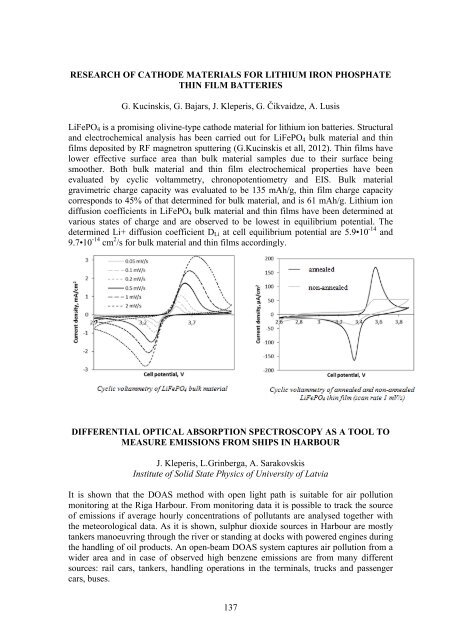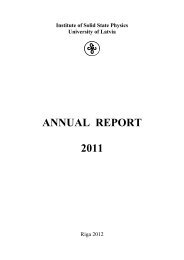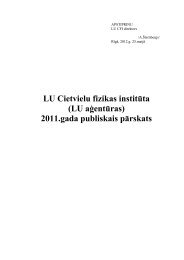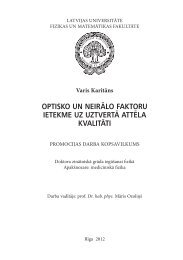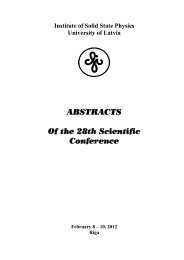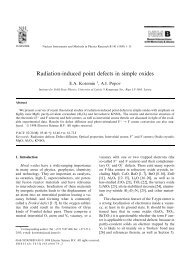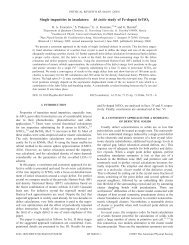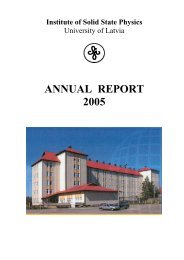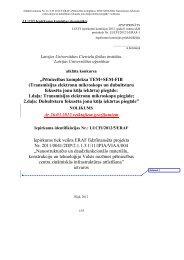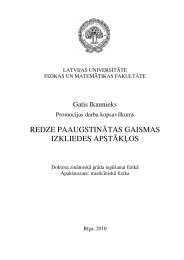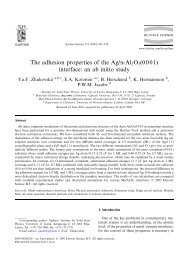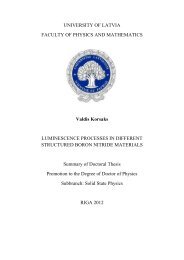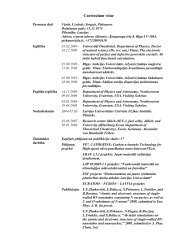Annual Report 2012 - Latvijas Universitātes Cietvielu fizikas institūts
Annual Report 2012 - Latvijas Universitātes Cietvielu fizikas institūts
Annual Report 2012 - Latvijas Universitātes Cietvielu fizikas institūts
You also want an ePaper? Increase the reach of your titles
YUMPU automatically turns print PDFs into web optimized ePapers that Google loves.
RESEARCH OF CATHODE MATERIALS FOR LITHIUM IRON PHOSPHATE<br />
THIN FILM BATTERIES<br />
G. Kucinskis, G. Bajars, J. Kleperis, G. Čikvaidze, A. Lusis<br />
LiFePO 4 is a promising olivine-type cathode material for lithium ion batteries. Structural<br />
and electrochemical analysis has been carried out for LiFePO 4 bulk material and thin<br />
films deposited by RF magnetron sputtering (G.Kucinskis et all, <strong>2012</strong>). Thin films have<br />
lower effective surface area than bulk material samples due to their surface being<br />
smoother. Both bulk material and thin film electrochemical properties have been<br />
evaluated by cyclic voltammetry, chronopotentiometry and EIS. Bulk material<br />
gravimetric charge capacity was evaluated to be 135 mAh/g, thin film charge capacity<br />
corresponds to 45% of that determined for bulk material, and is 61 mAh/g. Lithium ion<br />
diffusion coefficients in LiFePO 4 bulk material and thin films have been determined at<br />
various states of charge and are observed to be lowest in equilibrium potential. The<br />
determined Li+ diffusion coefficient D Li at cell equilibrium potential are 5.9•10 -14 and<br />
9.7•10 -14 cm 2 /s for bulk material and thin films accordingly.<br />
DIFFERENTIAL OPTICAL ABSORPTION SPECTROSCOPY AS A TOOL TO<br />
MEASURE EMISSIONS FROM SHIPS IN HARBOUR<br />
J. Kleperis, L.Grinberga, A. Sarakovskis<br />
Institute of Solid State Physics of University of Latvia<br />
It is shown that the DOAS method with open light path is suitable for air pollution<br />
monitoring at the Riga Harbour. From monitoring data it is possible to track the source<br />
of emissions if average hourly concentrations of pollutants are analysed together with<br />
the meteorological data. As it is shown, sulphur dioxide sources in Harbour are mostly<br />
tankers manoeuvring through the river or standing at docks with powered engines during<br />
the handling of oil products. An open-beam DOAS system captures air pollution from a<br />
wider area and in case of observed high benzene emissions are from many different<br />
sources: rail cars, tankers, handling operations in the terminals, trucks and passenger<br />
cars, buses.<br />
137


